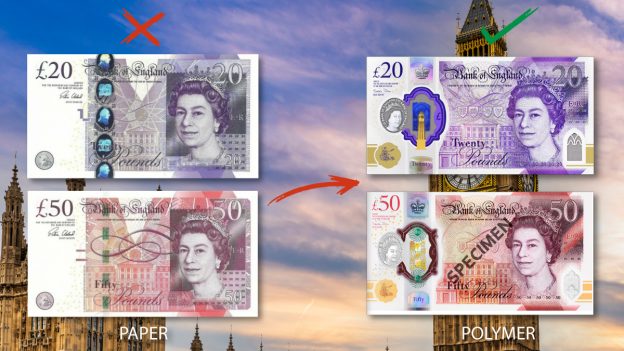At the end of 2021 the Bank of England announced that the paper UK 20 and 50 Pound banknotes are going to be demonetized and now only the polymer family will be legal tender. After this move the current UK 5, 10, 20 , 50 Pound banknotes will all be polymer. The Bank of England also has a press campaign telling people to exchange the paper bills for polymer ones before September 30, 2022. The 20 & 50 Pounds follows the same design as other banknotes. They feature Queen Elizabeth II with a historical building in the background. Reverse images feature notable figures like Winston Churchill, Jane Austen, JMW Turner, and Alan Turing. As time goes by the saying “out with the old and in with the new” remains valid.
In 1988 Australia pioneered the first polymer banknote with their $10 Dollars banknote. Over the last couple of years, more and more countries and their respective central banks are starting to switch over from paper to polymer. Jamaica is also releasing a brand new polymer series. Last year and this year UAE announced new 5, 10, 50 Dirham Polymer banknotes too. In December Barbados is also set to release a new family of polymer banknotes as well. The rest of the world has definitely taken a liking to polymer banknotes.
UK Understands Benefits of Polymer
You may be asking yourself why are more people switching over to polymer? Well, some of the benefits of polymer are that they are harder for criminal organizations to counterfeit. The chemical composition, new evolving security features and overall look and feel makes it harder for criminals to counterfeit. In addition polymer banknotes are approximately 2.5 times more durable than regular paper banknotes. At their core, polymer banknotes are basically a thin piece of plastic. They are waterproof so that means if you forget them inside of your favorite pair of blue jeans you just put in the washer, when you take them out they will still be in tact. As the technology advances and becomes more widely available the cost would also become more accessible for for central banks as well.
Sources:








How do I exchange paper pounds for the polymer ones now. My wife and I purchased these notes in 2020 in preparation for a trip to Scotland. This trip was canceled due to Covid. It was only this year we were able to sign up for a trip through the same hosts except that we were told that Scotland does not accept paper pounds any more. All local exchange locations do not accept these notes so what am I to do? We have 600 pounds worth of 20’s>
Hello, Mr Schuler this article from the Bank of England can help you:
https://www.bankofengland.co.uk/news/2022/september/one-week-left-to-use-your-paper-20-and-50-banknotes
After 30 September 2022 you will not be able to use paper banknotes. However the following options will remain available:
1) If you have a UK bank account, you will normally still be able to deposit them at your bank, or into your account at a Post Office.
2) You can exchange certain withdrawn paper banknotes for polymer notes at a limited number of Post Office branches. This is a new service, and the full list of branches is on our website.
3) You can exchange withdrawn banknotes with the Bank of England, including by post.